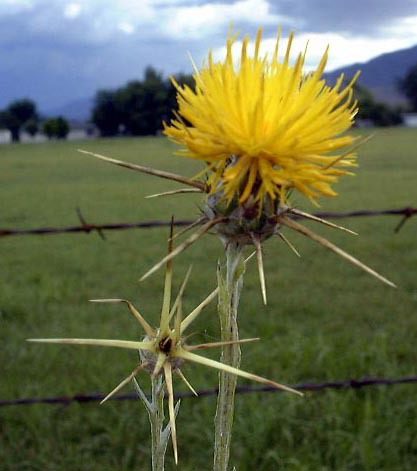The first time I heard the term “noxious weed” was the summer we moved to Sequim from Seattle. I had accepted a position at the local hospital. My love of words and their meaning drew me into learning more about “noxious weeds” — after all, I thought all weeds were noxious.
As it turned out, the newly built home we bought was surrounded by a landscape of noxious weeds, thistle being the most prevalent noxious bloom on the pile of rocks and sand that made up our yard.
We made our first trip to the Clallam County Fair that summer and the noxious weed booth was one of our stops where I learned that plants, grasses, trees or weeds can be termed “noxious weeds.” The key distinguishing feature of a noxious weed is that it is non-native and invasive to the extent that it threatens agricultural crops, local ecosystems or fish and wildlife habitat.
The problem, big enough for Washington State to have its own noxious weed control board, is still prevalent 17 years later. Just last weekend at a candidate forum for county commissioner position/District #1, I heard noxious weed control questions posed from very concerned citizens.
A personal noxious weed story
I was reminded of my meanderings about the term “noxious weeds” when I first arrived on the peninsula. I was coming into a position that promised me the chance to fulfill a career mission of helping to design a system of coordination across the settings that serve the typical Medicare patient – hospital for acute care, skilled nursing facility for continued medical management and rehabilitation and home care with home health to complete the care cycle.
I had been waiting for an opportunity like this and accepted the position at first part time so I could unwind my consulting business. Everything went well; our Seattle home sold quickly and we found a home in Sequim that we liked. Seemed like fate … until …
Less than a month after we arrived, the hospital board was voting to defund my position and the almost daily newspaper was running stories about my employment on the front page above the fold.
Even though the vote failed and my position remained funded, the message was pretty clear, especially when the administrator who hired me was soon gone taking the vision of coordinated services with him.
It was at this moment I begin to identify with the plight of noxious weeds and other entities or beings not readily accepted into a community. It was strangely comforting to have a context for the rejection I was experiencing.
Now, years later, I’m a long way and time from the unease that my husband and I had about our future and our blunder of faith. But it was a difficult time and I have never forgotten the lesson of mistaken identity as a noxious weed.
Mistaken noxious weed identity
In frankness, I must tell you it was not the first nor the last time I have been in the push-pull forces of change, just the most personally dramatic and public. A lot of my work has to do with change — the system, the program or the order of things, although always with a team of people, never by myself.
Change is difficult and often fearful. We are going through huge transitions in our culture, not the least of which is the change of work and skills needed to respond to technological advancement.
Our democratic system seems unable to respond in a less political and more proactive way. Much too often, either side of an argument points to an individual, group or ideology as the “noxious weed” that is invading our communities intent on the destruction of everything we have come to know as the way life should be.
“Class A noxious weeds are usually newcomers. They are often found in few places … and local boards hope to completely eradicate them before they get a foothold …” (WA Noxious Weed Control Board.)
Among other things, doesn’t it make you think of certain responses to immigrants, legal or otherwise? Is there a group who came to this country without experiencing some kind of discrimination (I can think of one)? I am the daughter of an immigrant and remember how hard my father tried to reduce his Norwegian accent, to no avail but he tried.
Currently a Presidential candidate is giving voice to people’s fears about being invaded by a foreign group. He warns of men being killed and women being raped. I have no doubt that rapists and murderers are the worst kind of human noxious weed, including those already growing in our country, but I mistrust the motives behind preaching fear.
Come to think about it, I could as easily say that the ones that broadcast fear and hate seeds about anyone or thing different are the purveyors of invasive human thought intended to destroy or control others. Fortunately, some purveyors are just annoying like a common weed but some are insidiously invasive and never quite leave our senses like the thistle still trying to make it in our yard.
Until we get this figured out, I will join the fight to control true noxious weeds, although I must admit that I often don’t know the difference and rue the days I pulled up a native plant thinking it was an unwelcome weed.
On a larger more human scale, we would do well to avoid cases of mistaken noxious identity of new friends by remembering the Washington State Weed Control Board statement.
“Only a very small fraction of non-native plants become invasive.”
Offhand, I can think of one that did.
Bertha D. Cooper is retired from a 40-plus year career as a health care administrator focusing on the delivery system as a whole. She still does occasional consulting. She is a featured columnist at the Sequim Gazette. Reach her at columnists@sequimgazette.com.


